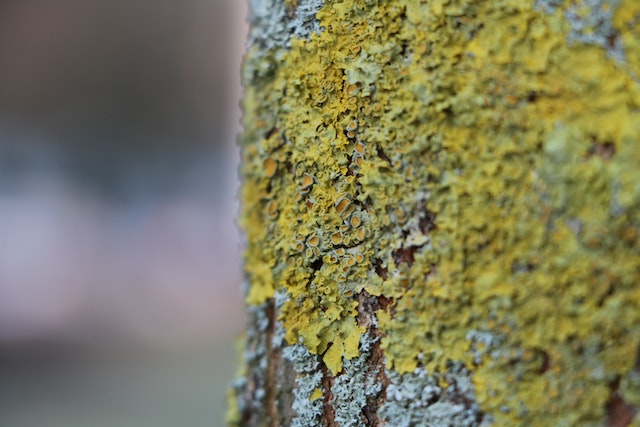
What is lichen? Lichen is not an organism. It is a symbiotic relationship between fungus and algae. There is some argument that the relationship is mutually beneficial, but there is another argument that the fungi are farming the algae.
There are about 20,000 different species of lichen and they cover approximately 8% of the land surface. Lichen can be different shapes and different colors depending on the fungi and the algae. They can look like tiny shrubs, with branches and leaves. They can also look like a jelly, and even a powder. Lichen grow from the area around the edge of the space they are covering, and they have a very slow growth rate. They grow at a speed of between one and two millimeters a year.
So, what are fungi and what are algae? Fungi are a group of organisms that are usually microscopic and are made of thread-like structures called hyphae that are smaller than 10 µm in diameter. Fungi cannot photosynthesize in the way that plants can, so they have to find their food source elsewhere. They are heterotrophs, like us, which means they need to take their energy from autotrophs, which can make their food from sunlight. Fungi do this by growing their hyphae into the soil or the mass of decaying material on the floor. They absorb nutrients from these decaying objects and use it for energy. Mold is a fungus, and when it appears on your bread, that is what it is doing. Fungi are vital because they work to break up decaying matter.
Algae are a group of aquatic organisms that are autotrophs. They can create energy through photosynthesis. Algae is not one thing. They can be single-celled organisms or larger multi-celled organisms. They contain chlorophyll in order to photosynthesize and they are the most primitive forms of life on Earth. There are fossils of algae that have been dated to three billion years ago. It is estimated that there are over 320,000 different types of algae. Algae don’t have roots or a circulatory system and they exist in water. They can survive in saltwater and freshwater. They can survive high and low temperatures, high and low oxygen or carbon dioxide concentrations, high or low levels of acidity. Algae have been found 200 meters under the polar ice caps and in the Dead Sea. Even though it looks like a plant, seaweed is actually a type of algae as well.
Why did fungi and algae come together? As we said, fungi cannot produce their own energy. When they allow algae to grow on them, they have access to a source of carbohydrates. This means they are less dependent on decaying material and can grow in many different places. So, what do the algae get out of the relationship? They have found a way to get out of the water and colonize the land. The fungi they are attached to give them a stable base across the land and support them so that they can photosynthesize. The fungi also keep the algae moist because they absorb and retain water from the atmosphere. Another reason is that the fungi produce chemicals that protect the algae from UV radiation, from drying out, and from being eaten.
Scientists believe that fungi and algae evolved this symbiotic relationship about 325 million years ago. They thought that lichen evolved before vascular plants, but the fossil record shows that plants came first. It also appears that lichen evolved separately in many different places.
So, is it a symbiotic relationship? There is evidence that both the algae and the fungi benefit from this relationship, although there is also evidence that the fungi are farming the algae as they get far more benefit than the algae do. Still, there is no way to prove that and it might end up just being semantics.
Some people eat lichen, and it can be nutritious. It was commonly eaten by Native American tribes during times of hardship. A lot of lichens are poisonous, but not all of them. Some lichens also have antibiotic properties. There is also talk of cultivating lichen as a food source in the future. It is very easy to grow and could be a good source of nutrition, while being better for the planet than the food we grow at the moment.
So, lichen is a symbiotic relationship between fungi and algae. The fungi get a food source. The algae get a way to live on land and protection. And this is what I learned today.
Sources
https://www.news-medical.net/life-sciences/What-are-Fungi.aspx
http://www.differencebetween.net/science/difference-between-algae-and-seaweed/
https://haeckels.co.uk/journal/edible-lichen
https://www.fs.usda.gov/wildflowers/beauty/lichens/didyouknow.shtml
https://www.science.org/content/article/hardy-lichens-don-t-actually-predate-plants
https://www.sciencedaily.com/releases/2019/07/190723163943.htm
https://britishlichensociety.org.uk/learning/what-is-a-lichen
https://en.wikipedia.org/wiki/Algae
https://en.wikipedia.org/wiki/Lichen
https://www.fs.usda.gov/wildflowers/beauty/lichens/about.shtml
